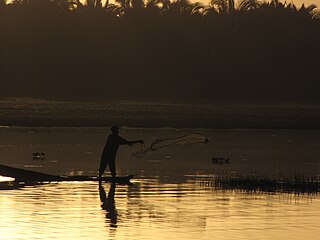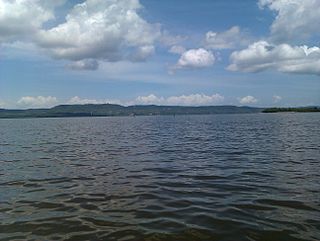Environment
The reserve is in the Cabo Frio region of Rio de Janeiro state, which includes the municipalities of Arraial do Cabo and Cabo Frio. It is in a flat region with small elevations, with dunes along the coast, broken by rocky headlands, islands and stretches of beach. The Saquarema and Araruama lagoon systems and the almost intact Restinga da Massambaba sandbank are important features. The region benefits from an upswelling of cold water originating in the polar region that is high in nutrients. The water is clear and supports a large population of fish.
Protected species in the reserve include the Barber goby ( Elacatinus figaro ), sea ginger ( Millepora alcicornis ), the sea urchin Paracentrotus gaimardi , the gorgonian Phyllogorgia dilatata , sperm whale (Physeter macrocephalus) and royal tern (Thalasseus maximus).
Economy
As of 2002 the municipality had a population of 23,877 inhabitants, with about 300 registered fishing families who had been fishing in the region for over 100 years. Within the reserve only traditional fishing vessels are allowed according to the utilisation plan, which aims for sustainable use of the marine fauna, as well as tourism and leisure activities. A variety of methods are used to catch fish including line fishing, small trawlers and underwater octopus hunting. A 2004 study showed that the local fishermen are well-informed about the biodiversity of the region and the different uses for the different species. Since the mid-1990s there has been rapid and uncontrolled growth of tourism, leading to conflicts between the artisanal fishermen and the companies operating tour boats and organising diving.

Tracuateua Marine Extractive Reserve (Portuguese: Reserva Extrativista Marinha de Tracuateua is a marine extractive reserve in the state of Pará, Brazil. It is used for small-scale farming and fishing, but the main activity is scavenging for crabs. The reserve is suffering from growing human pressure leading to dwindling stocks of resources.

Corumbau Marine Extractive Reserve is a coastal marine extractive reserve in the state of Bahia, Brazil. The reserve was created in 2000 to help protect the traditional local fishing economy, which was suffering from predatory commercial fisheries. It includes an area of corals and rich marine biodiversity, and a breeding ground for humpback whales. Growth in tourism has caused a surge in real estate prices and introduced new social problems among the traditional residents.

The Baía do Iguape Marine Extractive Reserve is a marine extractive reserve in the state of Bahia, Brazil. As of 2002 the reserve supported about 5,000 people engaged in fishing and shellfish collection.

The Maracanã Marine Extractive Reserve is a coastal marine extractive reserve in the state of Pará, Brazil. It protects an area of mangroves, and allows the local population to make sustainable use of the natural resources.

The Ituxi Extractive Reserve is an extractive reserve in the state of Amazonas, Brazil.
The Médio Purus Extractive Reserve is an extractive reserve in the state of Amazonas, Brazil.
The Lago do Cuniã Extractive Reserve is an extractive reserve in the state of Rondônia, Brazil.

The Prainha do Canto Verde Extractive Reserve is a marine extractive reserve in the state of Ceará, Brazil.
The Mocapajuba Marine Extractive Reserve is a coastal marine extractive reserve in the state of Pará, Brazil.
The São João da Ponta Extractive Reserve is a coastal marine extractive reserve in the state of Pará, Brazil.

The Mãe Grande de Curuçá Extractive Reserve is a coastal marine extractive reserve in the state of Pará, Brazil.

The Mestre Lucindo Marine Extractive Reserve is a coastal marine extractive reserve in the state of Pará, Brazil.
The Cuinarana Marine Extractive Reserve is a coastal marine extractive reserve in the state of Pará, Brazil.
The Chocoaré - Mato Grosso Extractive Reserve (Portuguese: Reserva Extrativista Chocoaré - Mato Grosso is an extractive reserve in the state of Pará, Brazil.
The Caeté-Taperaçu Marine Extractive Reserve is a coastal marine extractive reserve in the state of Pará, Brazil.
The Araí-Peroba Marine Extractive Reserve is a coastal marine extractive reserve in the state of Pará, Brazil.
The Gurupi-Piriá Marine Extractive Reserve is a coastal marine extractive reserve in the state of Pará, Brazil.

The Lagoa do Jequiá Marine Extractive Reserve is a coastal marine extractive reserve in the state of Alagoas, Brazil.
The Delta do Parnaíba Marine Extractive Reserve is a coastal marine extractive reserve in the states of Maranhão and Piauí, Brazil.
The Rio Jutaí Extractive Reserve is an extractive reserve in the state of Amazonas, Brazil.
This page is based on this
Wikipedia article Text is available under the
CC BY-SA 4.0 license; additional terms may apply.
Images, videos and audio are available under their respective licenses.










